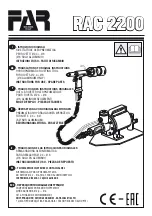
11
11
PART REMOVAL, REPLACEMENT & ADJUSTMENTS
REFER TO PAGES 12, 13, 14 & 15 FOR ADDITIONAL INFORMATION
FEEDWHEEL & WEAR PAD
1.
To replace the feedwheel (Pg13, #3), remove the
two socket head cap screws (Pg13, #15) and
lock washers (Pg13, #48) which secure the outer
link (Pg13, #51).
2.
Remove the outer link from the gear housing.
3.
Slide the feedwheel off the feedwheel shaft.
4.
The wear pad (Pg13, #22) can now be easily
replaced. Simply press out the wear plug from
the under side of the tool. Install the wear pad
with a new o-ring (Pg13, #17) making sure the
plug is solidly seated.
5.
Replace the feedwheel and outer link.
6.
Check the feedwheel to wear pad clearance. The
clearance between these parts should be .002"
to .006" (0.05-0.15mm). Adjust the clearance as
required by turning the M6 socket head set
screw (Pg15, #14). Turning the adjustment screw
clockwise increases the gap.
STRAP TENSION
Strap tension is controlled by air pressure. Use the
proper air line piping and lubrication as specified in
this manual. Your air pressure gauge must be
accurate, therefore, confirm its accuracy by
comparing it to a calibrated master gauge.
Adjust strap tension as follows:
1.
Make sure the air pressure is set between 70 and
90 psig (4.8 - 6.2 bar).
2.
Turn the adjustment valve screw (Pg15, #55) found on the underside of the air motor in 1/4
turn increments as required. Turn the screw clockwise to decrease tension and
counterclockwise to increase tension.
Strap breakage hazard. 3/4" (19mm) strap can break during tensioning if inlet air pressure to
the tool exceeds 90 psig. Strap breakage can result in severe personal injury. Maximum
operating pressure is 90 psig.
Never remove the adjusting screw from the tool with the air connected. The screw could
become a flying projectile.


































